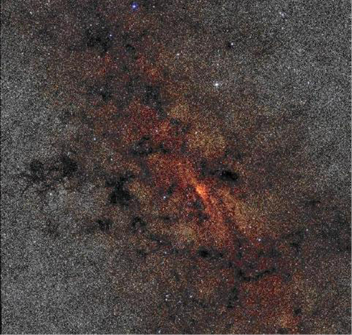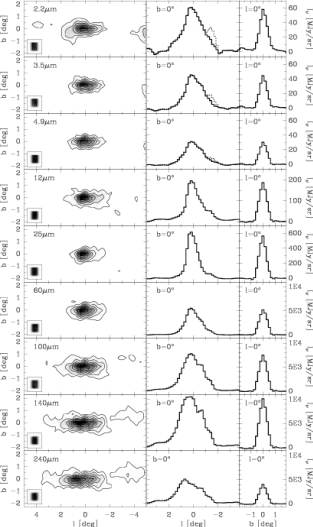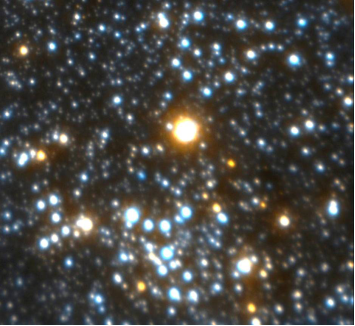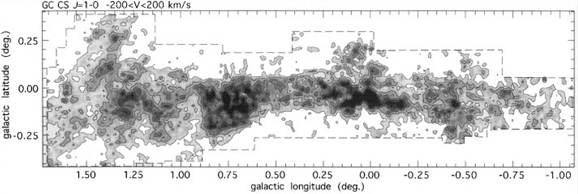


 الفيزياء الكلاسيكية
الفيزياء الكلاسيكية
 الكهربائية والمغناطيسية
الكهربائية والمغناطيسية
 علم البصريات
علم البصريات
 الفيزياء الحديثة
الفيزياء الحديثة
 النظرية النسبية
النظرية النسبية
 الفيزياء النووية
الفيزياء النووية
 فيزياء الحالة الصلبة
فيزياء الحالة الصلبة
 الليزر
الليزر
 علم الفلك
علم الفلك
 المجموعة الشمسية
المجموعة الشمسية
 الطاقة البديلة
الطاقة البديلة
 الفيزياء والعلوم الأخرى
الفيزياء والعلوم الأخرى
 مواضيع عامة في الفيزياء
مواضيع عامة في الفيزياء|
Read More
Date: 16-12-2015
Date: 24-1-2017
Date: 8-2-2017
|
The nuclear stellar bulge
The first near-infrared (NIR) mapping observation of the Galactic Center by Becklin and Neugebauer in 1968 revealed a central cluster of unresolved stars distributed with radius r as r-1.8 on a scale of a few hundred parsecs (100 pc = 40 arcmin at a distance of 8 kpc). The infrared light from this cluster is dominated by emission from red giant stars. This central cusp of stars, also called the ‘r-2 cluster’ or the ‘Nuclear Bulge’, is superimposed on the much larger-scale (∼2.5 kpc) bulge of our Galaxy. The Galactic Bulge has a bar morphology, as described. The three-dimensional morphology of the Nuclear Bulge, which resides well within the old Galactic Bulge, has not been determined, because of the difficulty in sorting out the highly variable extinction across the inner few degrees of the Galaxy.
Figure 1.1 shows a NIR image of the central few hundred parsecs of the Galaxy. The central cluster, or Nuclear Bulge, is evident among various patches of foreground extinction. With 30 magnitudes of visual extinction to the Galactic Center (a factor of 1012), the extinction at 2 μm is about three magnitudes (a factor of ∼10). This cluster reaches a maximum density exceeding 107 Mּ pc-3 in an uncertain core radius of ∼0.06 pc (Alexander 1999; Genzel et al 2000).
The history of the Nuclear Bulge is likely related to that of the Central Molecular Zone, given that they have comparable physical scales and that the current star formation rate in the CMZ is sufficient to populate the Nuclear Bulge, or r−2 cluster, over the lifetime of the Galaxy (Serabyn and Morris 1996). According to this hypothesis, the Nuclear Bulge is built up over a Hubble time by sustained star formation in the CMZ. The extent of the Nuclear Bulge is evident from the COBE images, shown in figure 1.2

Figure 1.1. Three-color, NIR image of the central 330 pc of the Galaxy, from the 2MASS Two Micron All-Sky Survey (2MASS). The Galactic plane runs through this image at a position angle of about 30o. (2MASS is a joint project of the University of Massachusetts and the Infrared Processing and Analysis Center/California Institute of Technology, funded by the National Aeronautics and Space Administration and the National Science Foundation.) See also color section.
(from Launhardt et al 1992). The fact that the Nuclear Bulge is substantially thicker than the cloud layer in the CMZ can be accounted for by the vertical diffusion of stars formed in the CMZ (Kim and Morris 2001). On timescales of a few Gyr, the scattering of stars by molecular clouds in the CMZ raises the stellar scale height to values comparable to those of the older OH/IR stars, about 44 pc (Lindqvist et al 1992).
The stars within the central parsec, where the Nuclear Bulge peaks, are shown in figure 1.3. This cluster, with an overall mass estimated at ∼109 Mּ, dominates the gravitational potential outside of about 1 pc. The black hole's

Figure 1.2. Surface brightness maps of the Nuclear Bulge, at nine wavelengths between 2.2 and 240 μm, as measured by the COBE satellite (from Launhardt et al 2002). These images are corrected for both emission and foreground extinction by dust in the Galactic Disk, and the emission from the much more extended Galactic Bulge has been subtracted. Lowest contour levels are at 10% of the maximum in the NIR maps and 5% in all other maps. Small boxes in the lower left of the maps show the DIRBE beam (HPBW = 0.7o) at the corresponding wavelength bands. The middle and right-hand panels show the corresponding longitude and latitude profiles at b = 0o and l = 0o, respectively.
domain of influence is therefore quite small. In addition to the intermediate age stars residing in the core of the Nuclear Bulge, the central parsec contains

Figure 1.3. Two-color (H: 1.65 μm and K' : 2.1 μm) image of the center of the Nuclear Bulge, showing a region 18 arcsc on a side (0.75 pc for a Galactic Center distance of 8 kpc). These data were acquired with the QUIRC camera behind the Hokupa'a adaptive optics system as part of the Demonstration Science Program of the Gemini North Telescope. See also color section.
a luminous young cluster dominated by emission-line stars (Krabbe et al 1995; Paumard et al 2001). The difficulty of estimating the core radius of the cluster is attributable to the high luminosity of the emission-line stars, which overwhelms the light from the older stars.
A very compact cluster of moderately luminous stars (mK = 14-16) lies within 0.5'' of the black hole: the Sgr A* (IR) cluster, discussed in detail. The blue color and featureless K-band spectra of these objects (Genzel et al 1997; Gezari et al 2002) indicate that they may be massive, young stars, although if they are lower-mass stars heated by some process peculiar to the immediate vicinity of the black hole, then they may represent the innermost members of the Nuclear Bulge.

Figure 1.4. Map of integrated CS J = 1–0 line emission, showing the spatial extent of relatively dense clouds in the CMZ, as measured by the 45-m telescope of the Nobeyama Radio Observatory (from Tsuboi et al 1999).



|
|
|
|
لخفض ضغط الدم.. دراسة تحدد "تمارين مهمة"
|
|
|
|
|
|
|
طال انتظارها.. ميزة جديدة من "واتساب" تعزز الخصوصية
|
|
|
|
|
|
|
أعمال المؤتمر العلمي السنوي الدولي الرابع عشر بعنوان .. "الإمامان الحسنان عليهما السلام صراطُ حقٍ ومشكاةُ معرفةٍ"
|
|
|